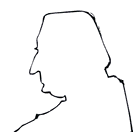Hitchcock thriller from 1940
 Dennis and I watched "Foreign Correspondent" tonight on Turner Classic Movies. It's a great Alfred Hitchcock movie that was made in 1940, the year that my mom graduated from high school.
Dennis and I watched "Foreign Correspondent" tonight on Turner Classic Movies. It's a great Alfred Hitchcock movie that was made in 1940, the year that my mom graduated from high school. Dennis watched for Alfred Hitchcock's cameo appearance through the whole movie, but somehow he missed it.
We speculated that he was one of the people in the movie's great crowd scene* where you look down at the round tops of dozens of open umbrellas and you follow the bad guy's escape by the disturbance he makes in the umbrellas.
However, according to an online list of Alfred Hitchcock's Cameo Appearances, Albert's appearance was "[e]arly in the movie, after Joel McCrea leaves his hotel, wearing a coat and hat and reading a newspaper." He must have been standing on the street.
Beyond the cameo which we didn't catch, the movie was dramatic with a complex spy thriller plot. The story and the relationships within it were interesting, and the plane crash scene at the end was amazingly realistic. There were quite a few creepy Hitchcock moments also, and some interesting plot twists.
We thought the movie was very much a glimpse back into the political turmoil immediately before World War II, as well as an interesting documentary of life as it was lived in 1940.
The movie ends with Joel McCrea standing at the microphone reporting to America from London. All the lights have gone out and bombs are falling. Americans who saw the movie in 1940 must have been chilled by his message:
Okay, we'll tell 'em then. I can't read the rest of the speech I had, 'cause the lights have gone out, so I'll just have to speak from the cuff. All that noise you hear isn't static - it's death, coming to London. Yes, they're coming here now. You can hear the bombs falling on the streets and on the homes. Don't tune me out, hang on a while - this is a big story, and you're part of it, it's too late to do anything here now except stand in the dark and let them come... as if the lights were out everywhere, except in America. Keep those lights burning, cover them with steel, ring them with guns, build a canopy of battleships and bombing planes around them. Hello, America, hang on to your lights: they're the only ones left in the world! (Source: Wikipedia)
As I listened to the "broadcast" of these words, I thought about my mother graduating from high school in 1940. I looked at a timeline of 1940 after the movie ended, and I can understand why she always stressed that her class graduated into a frightening and uncertain world. By May of 1940, Nazi Germany's blitzkrieg was well underway and western Europe was falling.
- - - - - - - - - -
*Crowd image appears on the Foreign Correspondent page of Alfred Hitchcock, The Master of Suspense
4 comments:
I BOUGHT that movie last summer. Blockbuster was getting rid of all their old video cassette rentals and it was on the rack for $3.00! Such a deal!
Here's something to ponder. You know that great scene you mentioned - the assassination attempt in the rain in Holland with the camera looking down at the massed umbrellas? According to Hitch's biography, the scene was shot in the sunshine on a summer day on a Hollywood back lot. With rain supplied by hoses. Those old Hollywood guys really knew how to create special effects.
Anyway, I agree. It's a great exciting movie on its own, but also a fascinating document of the world just before WWII.
TCM played it again today and I was able to watch it. Terrific movie. I wondered how they did the special effects for the plane crash scene. I kept thinking how good those scenes were during the movie. They talked about it a little after the movie, but didn't really go into how that part was filmed.
I read eight or ten reviews and webpages about the movie and didn't see even a mention about how the crash scene was filmed or where the windmill scene was filmed. I guess it all took place in Hollywood?
Thanks for the suggestion, Chronicler. It sounds like a movie that Dennis (the historian) would enjoy. I'm going to look for it.
Post a Comment